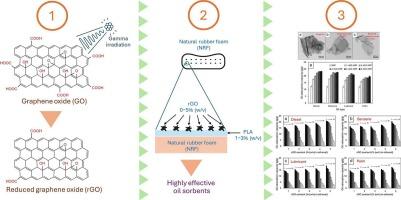Surface-coating of gamma-assisted reduced graphene oxide (rGO) on natural rubber foam (NRF) for enhanced oil adsorption performance
IF 5.1
3区 工程技术
Q1 CHEMISTRY, APPLIED
引用次数: 0
Abstract
Oil pollution poses a serious threat to both aquatic and terrestrial ecosystems, necessitating the need for efficient, reusable, and eco-friendly sorbent materials. To address this challenge, the present study investigated the coating of natural rubber foam (NRF) with reduced graphene oxide (rGO) to enhance oil adsorption capacity and mechanical durability, with polylactic acid (PLA) utilized as a binding agent to improve interfacial adhesion between NRF and rGO. The sorbents were fabricated by sequentially coating NRF with an optimized 2 % (w/v) PLA solution and rGO with varying contents (0–5 % w/v). The rGO was synthesized by gamma irradiation of graphene oxide (GO) at doses ranging from 0 to 65 kGy, in which 45 kGy was identified as the optimal dose for effective removal of oxygen-containing functional groups. The results also demonstrated that PLA coating substantially improved the adhesion of rGO to the foam surface, as evidenced by lower rGO detachment during water immersion and enhanced oil adsorption performance. Furthermore, the rGO-coated NRF samples exhibited increases in oil adsorption capacities—79 % for diesel, 88 % for benzene, 71 % for lubricant, and 57 % for palm oil—compared to pristine NRF, with adsorption performance reaching a plateau and optimal condition at 3 % (w/v) rGO. The reusability tests also confirmed the durability of the developed sorbents, with approximately 85 % of the initial adsorption capacity retained over five to six adsorption–desorption cycles. Overall, this study highlighted the potential of gamma-assisted rGO synthesis for the development of high-performance and sustainable oil sorbents for environmental remediation applications.

在天然橡胶泡沫(NRF)表面涂覆γ辅助还原氧化石墨烯(rGO)以增强吸油性能
石油污染对水生和陆地生态系统都构成了严重威胁,因此需要高效、可重复使用和环保的吸附材料。为了解决这一挑战,本研究研究了在天然橡胶泡沫(NRF)表面涂覆还原氧化石墨烯(rGO)以增强其吸油能力和机械耐久性,并利用聚乳酸(PLA)作为粘合剂来改善NRF和rGO之间的界面粘附性。用优化后的2% (w/v) PLA溶液和不同含量(0 - 5% w/v)的还原氧化石墨烯(rGO)依次涂覆NRF制备吸附剂。氧化石墨烯(GO)的γ辐照剂量为0 ~ 65 kGy,其中45 kGy被确定为有效去除含氧官能团的最佳剂量。结果还表明,PLA涂层显著提高了还原氧化石墨烯与泡沫表面的粘附性,表现为在浸水过程中还原氧化石墨烯的剥离率降低,吸附油性能增强。此外,与原始NRF相比,rGO涂层的NRF样品对柴油的吸附能力增加了79%,对苯的吸附能力增加了88%,对润滑剂的吸附能力增加了71%,对棕榈油的吸附能力增加了57%,吸附性能达到平稳状态,在3% (w/v) rGO时达到最佳状态。重复使用测试也证实了所开发的吸附剂的耐久性,在5到6个吸附-解吸循环中,大约85%的初始吸附容量保持不变。总的来说,这项研究强调了伽马辅助氧化石墨烯合成在开发高性能和可持续的环境修复应用的吸油剂方面的潜力。
本文章由计算机程序翻译,如有差异,请以英文原文为准。
求助全文
约1分钟内获得全文
求助全文
来源期刊

Reactive & Functional Polymers
工程技术-高分子科学
CiteScore
8.90
自引率
5.90%
发文量
259
审稿时长
27 days
期刊介绍:
Reactive & Functional Polymers provides a forum to disseminate original ideas, concepts and developments in the science and technology of polymers with functional groups, which impart specific chemical reactivity or physical, chemical, structural, biological, and pharmacological functionality. The scope covers organic polymers, acting for instance as reagents, catalysts, templates, ion-exchangers, selective sorbents, chelating or antimicrobial agents, drug carriers, sensors, membranes, and hydrogels. This also includes reactive cross-linkable prepolymers and high-performance thermosetting polymers, natural or degradable polymers, conducting polymers, and porous polymers.
Original research articles must contain thorough molecular and material characterization data on synthesis of the above polymers in combination with their applications. Applications include but are not limited to catalysis, water or effluent treatment, separations and recovery, electronics and information storage, energy conversion, encapsulation, or adhesion.
 求助内容:
求助内容: 应助结果提醒方式:
应助结果提醒方式:


